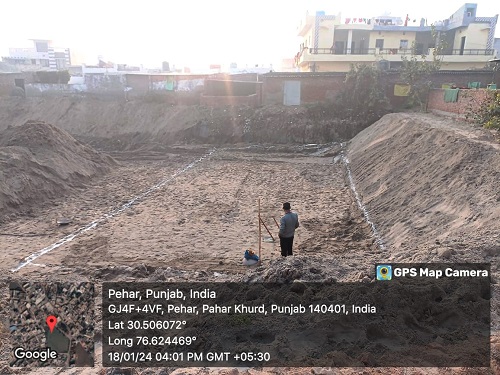
While the scale of India’s water crisis is overwhelming, The Art of Livings approach goes beyond numbers and statistics – it’s about empowering people to take ownership of the water challenge in their own communities. As Gurudev Sri Sri Ravi Shankar, renowned humanitarian, spiritual leader and founder of The Art of Living, often says, “Our survival depends on water. It is the basis of our life force. We need to protect and nurture the source of water.”
Pehar Khurd Pond (Punjab) Cleaning Work in Full Swing
The Art of Living’s River Rejuvenation Projects are not just about restoring water sources – they’re about encouraging local communities to take charge. Across 20,000+ villages, over 34.5 million lives have been impacted, with local villagers and volunteers actively participating in building 92,000 groundwater recharge structures, removing 270 lakh cubic metres of silt, and revitalising 59,000 square kilometres of land.
The Art of Living excels in developing sustainable models that are both innovative and easily replicable. The organisation’s community-driven approach ensures that water conservation is not just a temporary fix but a long term solution, safeguarding 174.02 billion litres of water annually and strengthening India’s water security.
The Bhujal Shakti River Rejuvenation Project
In the heart of Rampur district, Uttar Pradesh, The Art of Livings Bhujal Shakti River Rejuvenation Project is driving remarkable change. Chamraua Block, once labelled “overexploited” by the Groundwater Authority of Uttar Pradesh in 2017, is now a symbol of hope. Thanks to a powerful collaboration with local CSR partners, the region has witnessed impressive interventions. To date, 283 recharge shafts have been installed across 120 ponds, along with a subsurface dyke (SSD) across 74 villages in six talukas – helping restore vital groundwater levels.
This transformative impact hasnt gone unnoticed. In recognition of its groundbreaking efforts, the project was honoured with the Water Conservation Appreciation Award by Uttar Pradesh Chief Minister Yogi Adityanath for 2022-23.
But the momentum doesn’t stop there. The once-vanished Revati River, stretching 12.5 km through six villages in Chamraua Block, is coming back to life. Ongoing rejuvenation efforts are creating recharge structures in surrounding villages, breathing new life into this vital water source. Plans are already underway for the next phase, with Detailed Project Reports (DPRs) in progress for three additional blocks in Rampur, set to launch in the coming months with CSR backing.
This project is more than just water conservation; its a bold vision for sustainable water security, transforming communities and ecosystems for the better.
Gobind Sagar Catchment, Lalitpur District, Uttar Pradesh
The Gobind Sagar Catchment project in Lalitpur District, Uttar Pradesh, serves as a prime example of successful collaboration for sustainable water management. In partnership with Hindustan Aeronautics Limited, Vyakti Vikas Kendra India completed the construction of a Mini-Watershed, code named 2C2D1j2. During the 2022-23 period, the project saw the installation of 106 groundwater recharge structures, including 52 recharge wells, 52 boulder checks, and 2 recharge bore wells. These efforts are expected to significantly boost groundwater levels, reduce energy costs for irrigation, and provide a more reliable water supply for local agriculture.
Building on this achievement, a new initiative is underway to construct an additional 130 groundwater recharge structures, including boulder checks and recharge wells, across six villages in Lalitpur district. Supported by a CSR partner, ground truthing and location verification are currently being conducted, with construction set to begin shortly.
The Jal Shuddhi & Pond Rehabilitation Projects in Punjab and Rajasthan
The Art of Living is tackling the growing issue of water pollution head-on through its Jal Shuddhi & Pond Rehabilitation initiative. In Punjab, the project has successfully implemented two constructed wetlands, or Jal Shuddhi tanks, which are designed to reduce pollution and improve water quality. Meanwhile, in Bhiwadi, Rajasthan, efforts are underway to not only rehabilitate a village pond but also enhance its ecological health and beautify the surrounding area. These projects reflect The Art of Living’s ongoing commitment to restoring and revitalising essential water resources, benefiting both the environment and the local communities.
In the face of climate change and growing water scarcity, The Art of Living’s work highlights the power of collective action. With every village that learns to manage its water effectively, the ripple effect grows stronger – creating a brighter, more water-secure future for India.
About the Art of Living Social Projects
The Art of Livings holistic approach to preserving the environment is turning crisis into hope. Fostering change through vast tree plantations, restoring life to once-barren and polluted waterways, advocating natural farming for soil health are some of the many ingenious and sustainable Art of Living initiatives that revitalise communities, livelihoods, and even policies.
This is part 3 of a 5 part exploration into The Art of Livings transformative water conservation work across India.
Follow: www.instagram.com/artofliving.sp
Tweet: twitter.com/artofliving_sp
Message: www.linkedin.com/showcase/artofliving-sp


